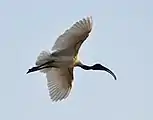| Black-headed ibis | |
|---|---|
.jpg.webp) | |
| Scientific classification | |
| Domain: | Eukaryota |
| Kingdom: | Animalia |
| Phylum: | Chordata |
| Class: | Aves |
| Order: | Pelecaniformes |
| Family: | Threskiornithidae |
| Genus: | Threskiornis |
| Species: | T. melanocephalus |
| Binomial name | |
| Threskiornis melanocephalus (Latham, 1790) | |
| Synonyms | |
|
Tantalus melanocephalus Latham, 1790 | |
The black-headed ibis (Threskiornis melanocephalus), also known as the Oriental white ibis, Indian white ibis, and black-necked ibis, is a species of wading bird of the ibis family Threskiornithidae which breeds in the South and Southeast Asia from India to the west and as far east as Japan.[1] It is the only native ibis species in its range that has an overall white plumage with a black neck and head. The down-curved beak and legs are also black. Though often referred to as a wetland species, the black-headed ibis forages in a range of natural and man-made habitats. This species of ibis nests only during the rainy season.
Description
The black-headed ibis is one of several large waterbird species in south and south-east Asia, with adults measuring 65–76 cm in length.[2] The white plumage is starkly contrasted against a conspicuous naked black neck and head, and black down-curved beak. Tails of adults bear light grey ornamental feathers that turn jet black during the breeding season. During the breeding season, bare patches under the wing turn blood-red. The head of some breeding adults gain a blueish tinge, or very rarely have a pink or bright red patch behind the neck.[3][4] Some breeding adults also develop tufts of white feathers behind the neck, and rarely also get a yellowish colouration on the breast and back. Sexes are identical but juveniles are identifiable from adults in having greyish feathering on the neck and speckled brown-grey feathering on the wings and back. Like storks and spoonbills, it lacks a true voice-producing mechanism and is silent except for ventriloquistic grunts uttered by pairs at the nest.[2]
Distribution and habitat
Black-headed ibis are native to the following countries: Bangladesh, Cambodia, China, Hong Kong, India, Indonesia, Malaysia, Myanmar, Nepal, Pakistan, Philippines, Russian Federation, Sri Lanka, Thailand and Vietnam. They are migratory or vagrant in Japan, Republic of Korea, Lao People's Democratic Republic and Mongolia.[1] The species is a widespread breeding bird in India, Sri Lanka, Nepal and Myanmar, and has declined considerably to few locations or breeding colonies in Cambodia, Indonesia, Malaysia, Thailand, and Vietnam. The most rapid decline in recent times is suspected to be the population in Sumatra.[5]
The black-headed ibis is very versatile being able to use a large variety of natural and man-made habitats. These include freshwater and salt-water marshes, lakes and ponds, as also rice fields, freshly ploughed crop fields, irrigation canals, riversides, reservoirs, urban lakes, open sewage gutters, grazing lots, and garbage dumping sites.[3][6][7][8] Ibis alter use of varied preferred foraging habitats by season in agricultural landscapes such as in south-western Uttar Pradesh in India. In summer, they largely use and prefer natural marshes and fallow fields, but in the monsoon, spread out more evenly to also use a variety of agricultural fields.[8] In landscapes that have more forests and rocky hills as in southern Rajasthan, wetlands are the preferred habitats year-round.[6] Open sewage lines are used more during the dry summers, and ibis increase the use of grazing lands during the monsoon.
It nests in heronry colonies near wetlands. It builds a platform nest of sticks, lined with grass and threads.[7]
Gallery

 Ibis landing on a tree, India
Ibis landing on a tree, India Ibis in flight
Ibis in flight
References
- 1 2 3 BirdLife International (2016). "Threskiornis melanocephalus". IUCN Red List of Threatened Species. 2016: e.T22697516A93618317. doi:10.2305/IUCN.UK.2016-3.RLTS.T22697516A93618317.en. Retrieved 19 November 2021.
- 1 2 del Hoyo, J.; Elliott, A.; Sargatal, J. (1992). Handbook of the Birds of the World. Volume 1: Ostrich to Ducks. Barcelona: Lynx Edicions. pp. 472–506.
- 1 2 Hancock, J.A.; Kushlan, J.A.; Kahl, M.P. (1992). Storks, Ibises and Spoonbills of the World. New Jersey: Princeton University Press.
- ↑ Kannan, V.; Manakadan, R.; Sykes, B. R. (2010). "Red patch on the hindneck of Black-headed Ibis Threskiornis melanocephalus in breeding colonies in India". BirdingASIA. 14: 99–100.
- ↑ Moses, S.; Zöckler, C. (2015) Bird survey Report Ayeyarwaddy Delta November – December 2015. Unpubl. Report for Fauna and Flora International. Fauna and Flora International.
- 1 2 Koli, V.K.; Yaseen, M.; Bhatnagar, C. (2013). "Population status of Painted Stork Mycteria leucocephala and Black-headed Ibis Threskiornis melanocephalus in southern Rajasthan, India". Indian Birds. 8: 39–41.
- 1 2 Chaudhury, S.; Koli, V.K. (2018). "Population status, habitat preference, and nesting characteristics of Black-headed Ibis Threskiornis melanocephalus Latham, 1790 in southern Rajasthan, India". Journal of Asia-Pacific Biodiversity. 11 (2): 223–228. doi:10.1016/j.japb.2018.01.013.
- 1 2 Sundar, K.S. Gopi (2006). "Flock size, density and habitat selection of four large waterbird species in an agricultural landscape in Uttar Pradesh, India: implications for management". Waterbirds. 29 (3): 365–374. doi:10.1675/1524-4695(2006)29[365:FSDAHS]2.0.CO;2. JSTOR 4132592.
Further reading
- Grimmett, Inskipp and Inskipp; Birds of India. ISBN 0-691-04910-6
